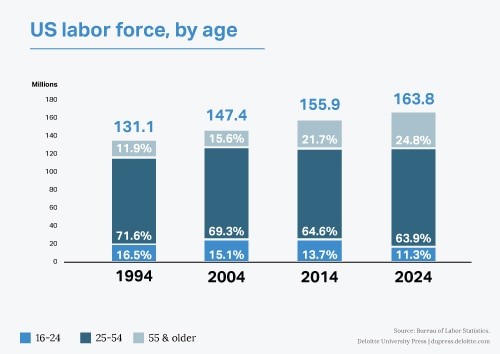Consumer experience is a brand’s most important competitive differentiator, and this holds true for educational institutions as well. With the shifting landscape of consumer behavior, educational brands have been propelled to change their marketing strategies.
In the Fall 2019 semester, approximately 18.2 million students enrolled in private and public colleges in the United States. These students represent the Gen Z consumer: the young, entrepreneurial and mobile generation, born between 1997 and 2015. In the US alone, the number of Gen Z individuals is expected to stand at 61 million, making up 11.3% of the country’s labor force by 2024.
It is quite natural then that educational institutions targeting this generation will need to tweak their marketing strategies, based on the changing needs and aspirations of Gen Z. The need to simply build an online presence for educational institutions is old hat now. Today’s higher education providers face other graver challenges, given the digital disruption across global markets and industries.
So, how do educational institutions attract students and cater to their needs? To engage new students, it is becoming critically important to speak their language online and start a conversation on familiar ground for them.
Mobile Friendly Website
More than 75% of Generation Z use smartphones to conduct online searches, rather than computers and other devices. In addition to designing intuitive websites, educational institutions must remember to keep their websites mobile friendly, to avoid missing out on a significant percentage of potential students.
In addition to consumer demand, the mobile friendliness of your website will also impact your Google rankings. You can move up in the search ranking at local levels through mobile-first indexing. Remember, there are three vital features that students are looking for in a website today:
- Easy navigation: Not wordy and complex, like the traditional university websites tend to be. Students get frustrated when they have to navigate through outdated content, broken links and confusing pages.
- Informative: Clearly visible vital information, like fees, curriculum and test dates.
- Rapid load time: Visitors to your site will move on to your competitor if your website takes more than 3-5 seconds to load.
Managed Ad Placement
If you want to talk about your latest online course, your unique theater program or tickets to the next show, or you are inviting applicants for a special workshop, it will be beneficial to place ads on relevant websites, focusing on higher education and career advancement.
The Discover Rutgers-Camden Day PPC campaign, launched by Rutgers University, concentrated on contextual and site-targeted ad placements in specific counties in New Jersey. The campaign resulted in 69% new users and 1.2 million impressions, giving Rutgers Law School in Camden a large pool of potential students to connect with.
Live Streaming Events
With over 71% of Gen Z teens using mobile devices to watch videos, the use of live streaming is an emerging digital marketing strategy. A few ways in which you can use live streaming include Q&A sessions, classroom sessions, conferences, live talks and events, such as sports activities. This can be a great way to build relationships with potential students. Facebook Live, Video Chat for Snapchat, Twitter’s Periscope and Instagram Stories are some channels you can use to build visibility.
Personalized Communication Strategies
Enrollment marketing is becoming extremely challenging with rising competition, rapid changes in communication tools, and a target audience that is highly adept at sniffing out authenticity. By personalizing and optimizing communication strategies, institutions can shorten conversion times on their digital channels. Students seek higher education for different purposes. According to Parthenon Group, university students can be broken into 6 segments:
- Aspiring academics: The 18- to 24-year-olds with impressive track records
- Career starters: In the same age group, but more career oriented
- Coming of age: Yet to decide what field to choose
- Career accelerators: Working students (slightly older), looking to advance career prospects
- Industry switchers: In the same age group as career accelerators but looking to switch work profiles and require additional skills.
- Academic wanderers: Adult learners, mostly getting into academics late in life.
Colleges need to identify which of these categories they wish to target through their marketing campaign and create content and communication strategies accordingly.
In today’s competitive higher education marketplace, colleges cannot rely on a one-size-fits-all user experience. Differentiation is the key to success.
Image source: https://www2.deloitte.com/content/dam/insights/us/articles/3884_Meet-the-US-work-force/DUP_Meet-the-US-workforce-reprint.pdf

